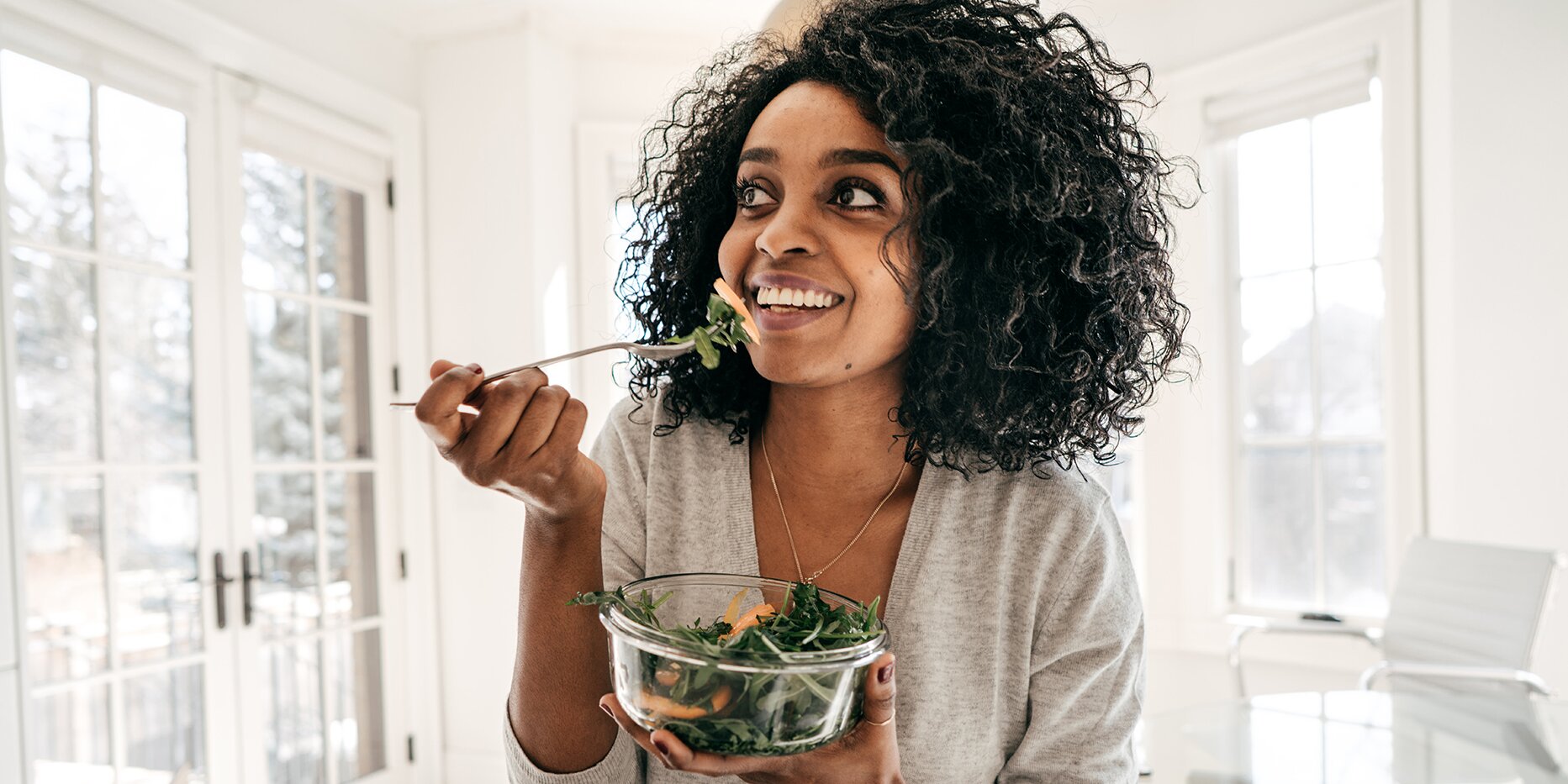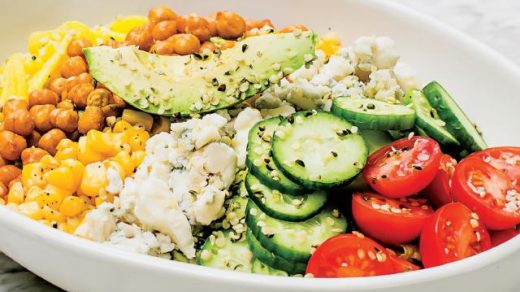Confused about what a portion size is of your favorite foods? You’re not alone. This portion size guide is here to coach you through healthy portion sizes for adults so you can nosh wisely and better understand how you’re fueling your body.
If you feel like you're suffering from portion distortion—I mean really, who eats ⅔ cup of ice cream and calls it a day?!—you're not alone. Research proves that humans struggle to accurately estimate portion sizes and the calories they score from foods by between 30 to 46%, according to a study published in the journal Appetite. And when we serve ourselves more than a healthy portion size, science bears out that we eat more total. Whether you're aiming to lose, maintain, or gain weight, it can be helpful to know food portion sizes so you can be an informed eater.
With the help of the latest Dietary Guidelines, the USDA's MyPlate, and Laura Burak MS, RD, founder of GetNaked® Nutrition and the author of Slimdown with Smoothies, we will dish up the ultimate portion size guide and explain the differences between serving sizes and portion sizes.
Healthy portion sizes are based on a 2,000 calorie diet, "but of course everybody needs different amounts of calories," Burak says. The latest food portion sizes from the USDA come packaged at three calorie levels: 1,600, 2,000, and 2,400 (you'll see all three broken out in the portion size guide below).
Before we dive in, it's important to explain the differences between serving sizes and portion sizes.
That said, "healthy portion sizes will literally differ for every single person. If you eat the exact amount as someone else you will not suddenly look like her. Try to be mindful of what you need at that moment, and remember that each day, your needs will even differ day to day based on activity level, hormone shifts, illness, and more," Burak adds.
Related: 15 Kitchen Tools That Make Healthy Eating Easier
So as you study up on portion sizes for adults, take them with a grain of salt. "Only you know what you need, so please honor that. And remember you have a built-in inner radar that is there to guide you from a young age, but you may have lost touch with it," Burak continues.
The weight and density of veggies matter, so the answer to "what is a serving size of vegetables?" varies. MyPlate defines a healthy portion size of vegetables to be 1 cup vegetable juice, 1 cup of raw or cooked vegetables, or 2 cups of raw leafy greens.
One cup, for reference, is about the size of a baseball or an adult fist. But you pretty much can't consume too much, Burak says: "Veggies are the key to volume eating because they are the best nutritious bang for the caloric buck." So feel free to add more salad greens, veggie-based soups, or crudités to any meal if you're feeling hungry. (Psst… these roasted vegetable ideas will have you craving more veggies and these delicious side-dish salad recipes might just steal the spotlight from the entreé.)
Sizes of whole fruits run the gamut, so everything from 1 large orange or peach to 3 medium plums to 2 to 3 kiwi fruit (depending on their individual size) counts as a healthy portion size of fruit. So what is a serving of fruit, exactly? To make a clearer food portion size guideline, MyPlate defines a single serving of fruit as 1 cup of fruit or 100% fruit juice or ½ cup of dried fruit.
Related: 18 Fruit Salad Recipes That Let Your Sweet Produce Shine
What is a serving of rice, bread, cereal, or pasta? MyPlate says that a serving of grains is a 1-ounce equivalent, which is 1 slice of bread, 1 cup of ready-to-eat cereal, or ½ cup of cooked rice, cooked pasta, or cooked cereal (such as oatmeal). At least half of the grains you consume should be whole grains, they advise, to keep your fiber intake strong and your gut healthy.
A whopping 90% of Americans don't get enough dairy, according to MyPlate, so they suggest the same servings of dairy for all calorie levels. MyPlate deems a portion size of dairy to be 1 cup of milk, yogurt, or non-dairy milk substitute, or 1½ ounces of cheese (which is slightly less than the size of a domino).
Burak says that a typical serving of protein should be about the size of a deck of cards, or 2 to 3 ounces. But since MyPlate has such a variety of protein portion sizes throughout the day and week, they break them out to 1-ounce equivalents again. Of course, 1 ounce of meat, poultry, or fish counts as that, and here's what also counts as equal to 1 ounce: ¼ cup cooked beans, 1 egg, 1 tablespoon of peanut butter, or ½ ounce of nuts or seeds.
While not considered an actual MyPlate portion since it comes packaged in other foods (see: fruit for the verdict on "what is a serving of avocado?"), the USDA breaks down additional oil grams to add to your daily diet. For reference, there are about 14 grams per tablespoon of olive oil, so for a 2,000-calorie-per-day diet, it would be about 2 tablespoons of added oil throughout the day.
Few people pause while out at happy hour or a restaurant dinner to consider, "hey, what is a serving of wine, beer, or cocktail?" But it can be helpful to become familiar with this—both to keep calories and alcohol intake in check. In the U.S. a "standard" drink has about 14 grams of pure alcohol, according to the NIH National Institute on Alcohol Abuse and Alcoholism. This correlates to:
If you veer off from the healthy portion sizes explained here, the best thing you can do is try to get back on track and listen to your gut the next time you eat.
"We tend to easily overeat carbs—like a warm basket of bread, a bowl of pasta, or baked goods like cookies—because they're so palatable. The comforting feeling while eating these foods precipitates wanting more and more, and it can feel difficult to just have a little," Burak says.
Related: Healthy Brown Bag Lunch Ideas for School, Work, and Life On-the-Go
Couple that feeling with the "I 'shouldn't' eat these foods, but now I messed up, so I might as well eat as much as I can now…" mentality, "and it is a recipe for people to easily overeat them," she adds. All of the foods that you love can be included as part of a nutritious diet, Burak concludes.
Healthy Portion Sizes | Better Homes & Gardens – BH&G





